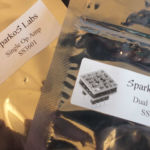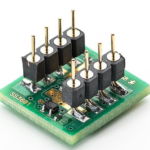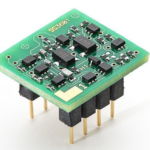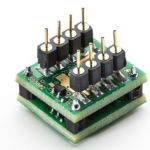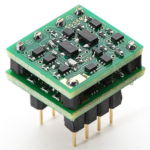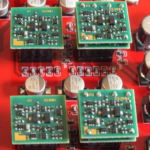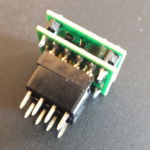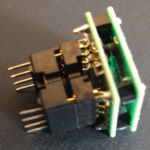SparkOS Discrete Opamps
Disclaimer: I purchased the SparkOS Opamps at a reduced rate after speaking with Andrew about doing a comparison of the SparkOS vs the Burson v5i and V6 Classic and Vivid as well as several solid state Op-amps in my collection. If you have an interest in purchasing these, I suggest you give Andrew a shout on Facebook or head to their website here.
If you are new to the Op-amp rolling, you may wish to ready my Intro to Op-Amps post for some background before diving into the details here.
Unboxing / Packaging:
Packaging is rather unspectacular and for an internal component, really doesn’t warrant a lot of discussion. Each Op-amp came in its own static bag to protect it and all were well packed which in my way of thinking is infinitely more critical than a pretty box. The upside was from time of order to time of arrival was less than a week and within 2 days of placing the order (Which I did in a somewhat unorthodox way as I spoke with Andrew and sent paypal but never made a formal order on the website) I had tracking info in hand. Customer service before the sale was fantastic, I have not had occasion to test the after sales support but would expect it to be equally good.
Design/Build:
Both the SS3601 and SS3602 versions share a similar construction so when discussing build we will cover the common elements first and then look at what differentiates the models. Both use a PCB of roughly 1/2 inch square with all circuitry on the upper surface and pins to fit a DIP-8 socket on the under side. The Circuitry is a 3 stage design with a differential input, a gain stage, and the output stage. A dual pole compensation mechanism is used and all phases are biased into class A at normal operational levels. Where the SS360x models differ from a lot of other opamps, is in the details. No Zener diodes are present in the gain stage and bias voltage is provided instead by shunt references (this is claimed to give lower impedence and lower noise). Current limiting of the gain stage is handled by diode clamping instead of the more common feedback loop to improve stability during clipping (With any luck we wont need this feature).
Probably the most interesting part of the design of the SS360x is the compensation mechanism. I discussed ringing and oscillation in my recent intro to op-amps post and both are often problems when switching from a pedestrian op-amp with a low slew rate to a more exotic with a much higher slew rate. Since the feedback circuitry on the board around the op-amp is usually involved in these processes, it is not possible for an op-amp to address 100% of the changes needed to prevent these failings. In a perfect world, if changing op-amps, we would look at the circuitry in the feedback mechanism and determine what changes were needed to it to address optimization of the new op-amp. Rarely is that feasible as these components are often surface mount and tiny leaving no room or mechanism to update or change them.
This is where the compensation mechanism built into the SS360x series comes into play. To provide both the much higher slew rate of the new op-amp and avoid the pitfalls usually associated with dramatic changes in speed, a dual pole compensation mechanism is used. This makes the SS360x much more tolerant of changes in capacitive loading and also to high feedback resistance at the inputs. Normally in order to minimize the chance of ringing or oscillation, either slew rate, bandwidth, or gain is lowered as a decrease in any of these reduces the likelyhood of ringing or overshoot. Unfortunately, decreasing any of these is counterproductive to our desires so a compensation mechanism that works to improve stability without decreasing any of the 3 is a very welcome improvement. This also goes a long way to explain why it is that SparkOS labs advertises the SS360x as a nearly universal swap as its internal compensation negates the need for slew rate, voltage, and gain matching between old and new op-amps as is often required if dealing with non-compensated designs (nearly all IC op-amps are non-compensated designs).
While the SS3601 uses a single PCB, the SS3602 stacks two modified SS3601 boards to create the double op-amp and stands taller than the single as a result. Pin-outs for both chips follow the standard Dip-8 patterns and SparkOS even offers a DIP to SIOC option for locations where it is needed if you have the attendant skill to do the soldering. I’m best leaving that to the professionals as I have found out by having to pay others to fix my attempts.
For those interested in all of the technical details, SparkOS labs has a 18 page datasheet available in PDF format here.
Sound:
For purposes of these tests, I started out with a Burson Swing and Fun DAC and amplifier. These were wired to use USB input to the Swing from my laptop, the DAC (fixed voltage) RCA outputs of the Swing to the RCA inputs on the Fun, and the Hifiman He560, Sennheiser 800, and Campfire Cascade (with Cloth pads) used for all listening sessions. Sound notes are written in reference to replacing all the Ne5532 and 5534 op-amps in both devices with the appropriate SS360x op-amp in its place. For that reason, I have not included the base model Op-amps in the comparison section as it would duplicate the sound discussion.
Bass:
Bass depth was improved slightly to my ear, but detail was improved substantially. I found the SparkOS to have a more crisp, clean sound while the Ne553x sounded more rounded off and smoothed over by comparison. I also found the SparkOS to be more dynamic than the Ne553x with really thunderous passages being closer to real than with the stock models. This was particularly true of things like cannon fire in tchaikovsky’s 1812, Beethoven’s Ninth Symphony (second movement), Strauss’s Also sprach Zarathustra, Shostakovich No. 5 (finale), or the booming Timpani Duet.
Mids:
The same trends carry through to the mids where again details are sharpened and dynamics are a bit expanded compared to the stock op-amps. Strings in particular have a more natural tone and vocals are actually slightly behind where they are with the Ne553x and more in-line with the rest of the signature(I don’t see this as a bad thing). I do think the SparkOS tends to lift the lower mids slightly (or the 553x is slightly recessed in comparison) which may account for the noted improvements in strings and acoustic guitars.
Treble:
Treble really shines on the SS360x and is the best I have heard to date out of the Swing/Fun combination. Treble seems effortless and infinite with no discernible roll-off. The attack of snares is spot on without cymbals taking on a metallic or click like sound (tough balance to get both right). Here again the attack and display speed of the SS360x is on full display and where other op-amps at time my seem more flowing, the SS360x does a great job at revealing what is there good or bad. This means at times the treble sounds crisp, clean, and natural and at times it sounds harsh, and quite strident depending on the recording. Recordings with sibilance sound sibilant, recordings that don’t have it inherently don’t show it when using the SS360x.
Soundstage / Imaging:
Ok, so this one is the hardest to write, can we really expect soundstage to change as a result of swapping one tiny part in the overall or are we now hearing the result of some other component and blaming it on the op-amp? To really get this down, I used the same headphone (He560) and ran the test using the same passages (Cowboy Junkies – I’m so Lonesome, and Keith Richards – Runnin too Deep) repeatedly while switching only the op-amps between runs. (SWMBO is happy to have her dining room table back now that I have put the covers back on the Burson twins). The outcome is yes, I do think you can hear differences in both stage and imaging depending on what op-amp is in use. The SS360x improved the imaging due to its precision and yielded better instrument separation which either improved the stage size or made it seem larger due to the cleaner divide between parts. I also enjoyed the improved layering provided by the SS360x as again I think the precision made it easier to hear all the parts individually rather than the amalgam produced by the Ne553x.
Comparisons:
vs Muses02
The v5i semi-discrete op-amp in the walnut did have one immediately noteworthy difference. It is louder at the same setting compared to any of the IC designs. This throws another wrinkle into the testing as we all know a louder sample is usually perceived as a more detailed sample. I did my best to volume match the samples so I could judge fairly. At the end of my testing, I found that it really depended on genre as to which Op-amp I preferred. The stock 2134 was closer to neutral and was technically very good. The muses brought a touch more musical presentation and was less clinical sounding than the 2134. Vocals are farther forward on the Muses which makes it an excellent choice for music where the primary element is vocals (I dig me some Pentatonix). The v5i brought a bit more energy to the presentation but seemed to be less neutral in doing so. Sub-bass is forward of midbass and upper mids and lower treble are the other focal point making for a more lively if slightly less technically correct presentation. If the muses shines with Vocals, the v5i is made for electric guitars. The place where the v5i was truly fantastic was on classic rock where it brought you into the concert and made you feel like you are sitting on the front row. Soundstage was a bit wider on the Muses but depth was about equal and extension was a split decision. At the low end, the v5i did a better job but on the other end of the spectrum the Muses had more air and sparkle to its presentation. I could live with either the v5i or the Muses, but in my case the fit inside of portable amps and the genre’s I prefer again left me in a split decision. Ultimately, I left the Muses in the Walnut F1, and put the V5i in the Zishan DSD. When paired together, I get the best of both worlds.
vs Burson v5i
The v5i is a clear winner vs the 553x series but a solid step behind the SS360x in most aspects. I found the details better, the attack faster, and the bass to have more mass to it using the SS360x when compared to the v5i. I did think the v5i had a bit of bass thump that the SS360x did not as the SS360x came across a bit brighter by comparison.
vs Burson V6 Classic
The V6 classic was a bit slower on the attack than the SS360x which gave it a bit smoothed over sound compared to the SS360x. Details are better on the SS360x while Bass may have had slightly better slam on the Classics. Classics are a bit warmer while SS360x is a bit brighter presentation. Noise floor is lower on SS360x as testing with Magaosi K5 from the fun yielded no audible noise without moving the volume dial past the 35% mark for SS360x and 20% for classics.
vs Burson V6 Vivid
The V6 Vivid has a faster attack than the classic, but still not quite as fast as the SS360x which allows the SS360x to wring out just slightly more detail than the Vivids. One other very noteworthy difference is the Vivid has a strong attack, but loses a bit on the decay so sustain is better on the SS360x. Overall, the Vivid trades a little detail and texture for attack speed compared to the classic while the SS360x seems to manage to capture both that attack speed and the details.
Thoughts / Conclusion:
Right off the bat, I will have to say there are no losers here. The Swing/Fun with the base model op-amps are both very solid products and thoroughly enjoyable without any modifications. Moving up to the Muses02, Burson V5i or V6 versions, or the SparkOS SS360x are all steps forward and all have something going for them. For those who need to converse space, the v5i or Muses02 will win out as the Muses is an IC and the v5i is only slightly larger than an IC. The Muses02 has been a favorite of mine and the only drawback is having to use dual to single adapters as there is no single op-amp counterpart for the 02. The V6c has good detail and texture but lacks a bit in attack speed, the V6v takes the opposite approach and pushes attack speed but loses a bit of detail and timbre in the process. Then we come to the subject of this post, the SS360x. These offer fantastic attack speed, great detail and timbre, and bring a lot of the best features of all of the others into a single product. If there is a downside to be mentioned, the SS360x is brighter than some of the other offerings (especially Muses02/v6c). Those with a particular treble sensitivity may prefer the V6c. Those wanting to wring out absolutely every last detail will want the SS360x. I repeatedly used words like sharp edged, clean, and clear in my notes while writing this. If you have a dac or amp with sockets for the op-amps you may want to audition the SS360x before you upgrade to another product, you may find the swap improves your existing amp or dac enough that you decide to keep it. For me, I find the Swing/Fun combined with the SS3601/3602 combination gives me as good as sound as I have heard to date from my He560, Senn HD800, and Cascades. I may need a more resolving headphone in order to know if another op-amp could do any better.
-
Bass - 9/109/10
-
Mids - 9/109/10
-
Treble - 9.5/109.5/10
-
Soundstage - 9/109/10
-
Imaging - 8.5/108.5/10
Summary
Pros: Razor sharp details and dynamics to die for, combines the best qualities of the other models I have tried to date.
Cons: too large to fit into some portable models and get case re-installed, Slightly bright (may bother the treble sensitive), More costly than some alternatives.


